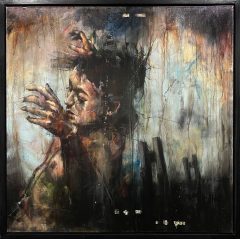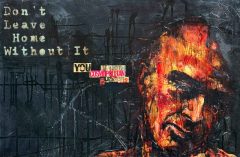Guy Denning
Showing all 2 results
-

Guy Denning – At the End of the World (No Longer Available)
-

Guy Denning – Don’t Leave Home Without It (New In)
£1,999
Guy Denning
Guy Denning was born in North Somerset in 1965. He has been obsessed with visual art since childhood and started painting in oils at the age of eleven after receiving a set of old paints from a relative that had grown bored with them. Through the 1980s, Guy Denning was repeatedly unsuccessful in his applications to study painting at degree level, but continued creating and learning the technical aspects of oil painting from more experienced painters that he knew in Somerset. He continued to study Art History and received his degree from The Open University.
Denning had various jobs from the age of 20, to support his family, while continuing to paint. Since he grew up in a Somerset village outside Bristol and saw the local rural economy crumble throughout the 1980s, he has been interested in responding to society in one type of political narrative or another.
With his discovery in 1980 of the bands CRASS, The Dead Kennedys and Poison Girls, Denning associated himself with the second wave of punk and saw the light in terms of street art. Following the stencilled text aesthetic and anarchist politics of the band CRASS, and the photo-montage vision of artist Gee Vaucher, Denning started peppering west-country towns with his particular paste-up style and sometimes surreal political messaging. In a time when graffiti was generally defined by a US styled, hip-hop inspired vision Denning would frequently challenge what seemed to him then as a style with little political content. His preferred attack was to simply stencil the word “WHY?” next to this ‘traditional’ graffiti that he found when carrying his paint and stencils.
College
In his college applications he was told that he needed to move away from his overtly figurative style and to be more subtle in regards to how he confronted politics as a subject matter. He was too literal, they said, and too ferocious. His crudely photocopied paste-ups were declared too graphic, the subject matter was inappropriate for fine art and photocopying was not considered a legitimate art printing method. He was also surprised and not a little angry that his distinct Somerset accent became the subject of conversation at one of these interviews.
Instead of listening, he refined his technique. Instead of giving up, he learned to become resilient, disciplined, focused. So, to conclude: Guy Denning had no choice; he taught himself how to be an artist.
Denning has an impressive but unorthodox affinity with mixing media and techniques together. Stencils, spray cans, brushwork, dripping paint, crayons, gold-leaf, marker pen and conté pastel… Some pieces drawn on mid-toned paper, newsprint or torn packing card that give them an expressive economy. The mid tones are already there, which means he can focus his powerful and deceptively simple draughtsmanship all the more on the contrast and highlights added in black and white.
With his painting Denning uses not only powerful brush strokes to express himself but also scratches and tears the paint and surface to an extent where he has had to crudely stitch it back together. He frequently adds stencilled and collaged text to oil paintings.
He has been invited to work on a variety of community urban art projects where he has developed a distinctive style that builds images from drawing and text.
In 2010, Denning presented 30 paintings based on stills from 1928 film “La Passion de Jeanne d’Arc”, tackling historical political machinations, at the London exhibition titled “Behemoth”.
In 2011 he presented “Inferno”, the first part of his three-part series of oil paintings on Dante’s Commedia in Bologna; this was his first exhibition in Italy and the complete exhibition sold out.
Creative
In 2011, he presented the second part of the series in New York City for the exhibition “Purgatorio”. Originally drawing inspiration from Dante’s writings, his intention was not to recreate the poem in a visual or literal sense, but instead let the “Purgatorio” series act as a framework for his own personal interpretation of the world following 9/11. As with the writing of Shakespeare, Denning finds a perpetual relevance in Dante’s work where the specifics of name, situation and place are easily adapted to the modern world; as if time moves on but the problems of humanity remain essentially the same. The events of September 11th and the emotional toll it took on the US identity was a critical element to this body of work. Poignantly enough, this exhibition was held in a ‘pop-up’ location just blocks from Ground Zero and on the 10th Anniversary of the 9/11 attacks.
His 2015 show in Paris, coinciding with the COP21 climate talks, was aptly named “The Party is Over” and it focused on our belonging to the last generation enjoying an abundance of natural resources, with future generations having to mop up the mess after our hangover. It was a gallery exhibition following a year where Denning had been pasting up his “Paradis est ici” angel drawings worldwide and talking to groups of students to bring greater attention to the COP21 talks.
In February 2016, Denning had his most recent solo exhibition at La Neomudejar de Atocha in Madrid. The show continued his exploration of political and environmental issues through a series of artworks depicting angels, refugees and portraits related to the recent COP21 event in Paris; all created in his dark, dramatic, even Baroque, style. With nods to the work of one of his main painting heroes, Francisco Goya, Denning’s work was very well received by his first Spanish audience and a piece entered the museum’s permanent collection.
Guy Denning is an unbelievable blend of talent, intelligence and sheer courage. The fact he is mostly self-educated only brings more admiration to his portfolio. Not many street artists reach the heights that Denning has, let alone simultaneously cross the borders into contemporary, urban and fine art whilst referencing the grand tradition of European pre-Modernist painting.
Public Collections
His work is also held in several other public collections, including the Politics Department of Bristol University, the Political Science Department at Galway University, the MAGI’900 Museum of Contemporary Art, Bologna and the Musée des Beaux-Arts de Brest.


